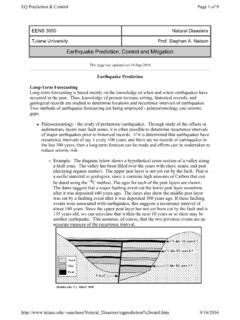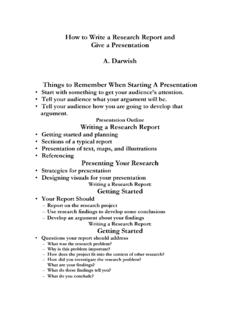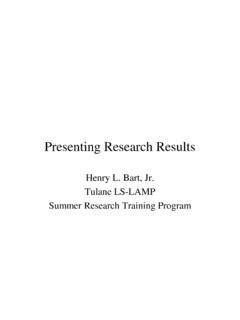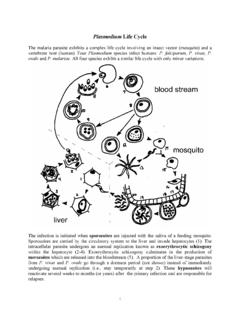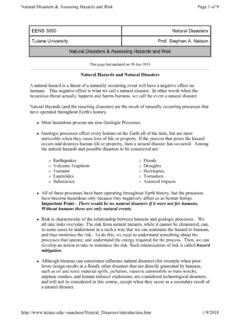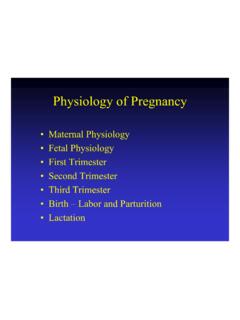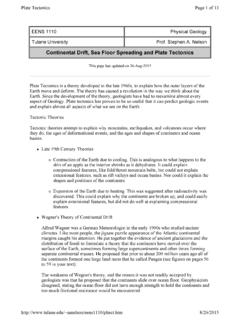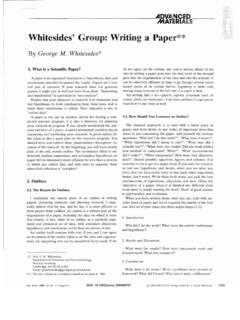Transcription of Introduction and Origin of the Earth
1 This page last updated on 30-Jul-2015 EENS 1110 Physical GeologyTulane UniversityProf. Stephen A. NelsonIntroduction and Origin of the Earth Geology, What is it?Geology is the study of the Earth . It includes not only the surface process which have shaped the Earth 's surface, but the study of the ocean floors, and the interior of the Earth . It is not only the study of the Earth as we see it today, but the history of the Earth as it has evolved to its present condition. zImportant point: The Earth has evolved (changed) throughout its history, and will continue to Earth is about billion years old, human beings have been around for only the past 2 million years.{Thus, mankind has been witness to only of Earth history.}
2 {The first multi-celled organisms appeared about 700 million years ago. Thus, organisms have only been witness to about 15% of Earth 's history. Thus, for us to have an understanding of the Earth upon which we live, we must look at processes and structures that occur today, and interpret what must have happened in the past. One of the major difficulties we have is with the time scale. Try to imagine 1 million years--That's 50,000 times longer than most of you have lived. It seems like a long time doesn't it? Yet, to geologists, 1 million years is a relatively short period of time. More discussion about time in later lectures. But one thing we have to remember when studying the Earth is that things that seem like they take a long time to us, may take only a short time to Earth .}
3 Examples:z A river deposits about 1mm of sediment (mud) each year. How thick is the mud after 100 years? -- 10 cm hardly noticeable over your lifetime. zWhat if the river keeps depositing that same 1 mm/yr for 10 million years? Answer 10,000 meters ( miles). Things can change drastically! Page 1 of 5 Introduction7/30/2015 ~sanelson/eens1110 Study the Earth ?z We're part of it. Dust to Dust. Humans have the capability to make rapid changes. All construction from houses to roads to dams are effected by the Earth , and thus require some geologic knowledge. All life depends on the Earth for food and nourishment. The Earth is there everyday of our lives. zEnergy and Mineral resources that we depend on for our lifestyle come from the Earth .
4 At present no other source is Hazards -- Earthquakes, volcanic eruptions, hurricanes, landslides, could affect us at any time. A better understanding of the Earth is necessary to prepare for these eventualities. zCuriosity-- We have a better understanding of things happening around us. Science in general. I'll try to relate geology (and science in general) to our everyday lives. How did the Earth originate?zWe start at the beginning of the Universe, when, about billion years ago, the Big Bang created the universe from a point source. zDuring this process, light elements, like H, He, Li, B, and Be formed. From this point in time, the universe began to expand and has been expanding ever since. (See figure in your text) zConcentrations of gas and dust within the universe eventually became galaxies consisting of millions of stars.
5 ZWithin the larger stars, nuclear fusion processes eventually created heavier elements, like C, Si, Ca, Mg, K, and eventually collapse and explode during an event called a supernova. During a supernova, heavier elements, from Fe to U, are formed. (See figure in your text). zThroughout galaxies clusters of gas attracted by gravity start to rotate and accrete to form stars and solar systems. For our solar system this occurred about billion years ago. zThe ball at the center grows dense and hot, eventually nuclear fusion reactions start and a star is born (in our case, the sun).zRings of gas and dust orbiting around the sun eventually condenses into small particles. These particles are attracted to one another and larger bodies called planetismals begin to accumulate into a larger mass.
6 An irregularly-shaped proto- Earth develops. zThe interior heats and becomes soft. Gravity shapes the Earth into a sphere. The interior Page 2 of 5 Introduction7/30/2015 ~sanelson/eens1110 into a nickel-iron core, and a stony (silicate) , a small planetoid collides with Earth . Debris forms a ring around the debris coalesces and forms the atmosphere develops from volcanic gases. When the Earth becomes cool enough,moisture condenses and accumulates, and the oceans are born.(see graphic on pages 30 and 31 of your text). The Earth -- What is it? The Earth has a radius of about 6371 km, although it is about 22 km larger at equator than at , (mass/volume), Temperature, and Pressure increase with Structure of the Earth : Earth has layered structure.
7 Layering can be viewed in two different ways:1. Layers of different chemical composition2. Layers of differing physical properties. Compositional Layering{Crust -variable thickness and composition Continental 10 - 70 km thick - "granitic" (made mostly of Oxygen and Silicon) in composition Page 3 of 5 Introduction7/30/2015 ~sanelson/eens1110 Oceanic 2 - 10 km thick - "basaltic" (less Silicon than in continental crust, more Magnesium) {Mantle - 3488 km thick, made up of a rock called peridotite. Solid but can deform so that it confects (moves in response to temperature differences). {Core- 2883 km radius, made up of Iron (Fe) and small amount of Nickel (Ni) Layers of Differing Physical Properties {Lithosphere - about 100 km thick (deeper beneath continents) {Asthenosphere- about 250 km thick to depth of 350 km - solid rock, but soft and flows easily.}}}}}
8 {Mesosphere- about 2500 km thick, solid rock, but still capable of flowing. {Outer Core- 2250 km thick, Fe and Ni, liquid {Inner core- 1230 km radius, Fe and Ni, solid All of the above is known from observations that have been made from the surface of the Earth , in particular, the way seismic (earthquake waves) pass through the Earth as we will discuss later in the course. The atmosphere is the outermost layer. It has the lowest density and consists mostly of Nitrogen (78%) and Oxygen (21%).Composition of the EarthThe bulk chemical composition of the Earth is mostly Iron (Fe, ), Oxygen (O2, ), Silicon (Si, ), and Magnesium (Mg, ), with other elements making up the other 8%.These elements are distributed unevenly due to the layering, with Fe being concentrated in the core, Si, O2, and Mg being concentrated in the mantle, and Si, O2, and the other elements being concentrated in the thin veneer of the crust.}}}
9 How do we study the Earth ? In order to understand the Earth , we must use the scientific method. This first involves making observations concerning what it there, what it is made of and what processes are operating. These observations are then used to develop hypotheses or theories to explain what we see. These hypotheses or theories are then tested by making further observations, doing experiments, or doing some kind of modeling, either physically or theoretically. An idea proposed early in the history of human study of the Earth was the principle of 4 of 5 Introduction7/30/2015 ~sanelson/eens1110 of UniformitarianismProcesses that are operating during the present are the same processes that have operated in the past.
10 The present is the key to the past. If we look at processes that occur today, we can infer that the same processes operated in the : zRates -- rates of processes may change over time for example a river might deposit 1 mm of sediment /yr if we look at it today. but, a storm could produce higher runoff and carry more sediment tomorrow. Another example: the internal heat of the Earth may have been greater in the past than in the present -- rates of processes that depend on the amount of heat available may have changed through -- we may not have observed in human history all possible processes. Examples: Mt. St. Helens, Size of earthquakes. Perhaps a better way of stating the Principle of Uniformitarianism is that the laws of nature have not changed through time.
